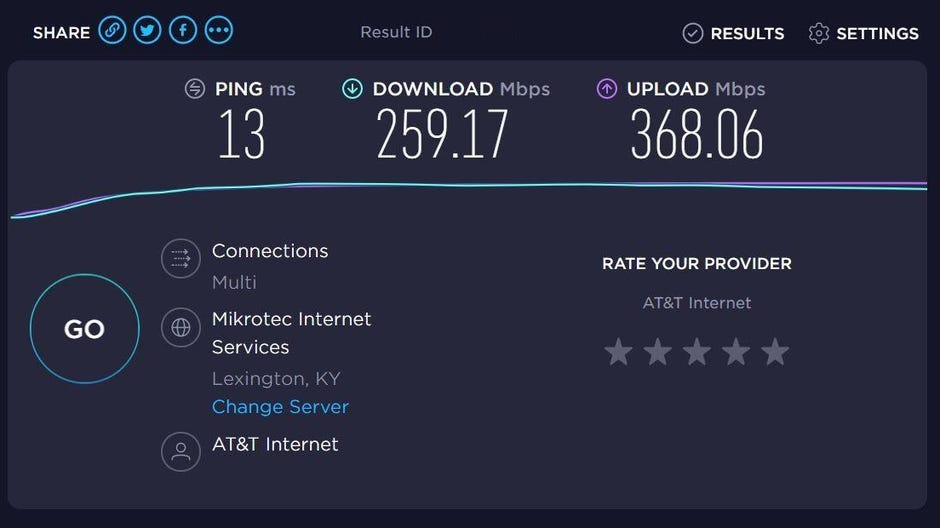

- Lan speed test gigabit results 64 bits#
- Lan speed test gigabit results software#
- Lan speed test gigabit results mac#
At least four 10Gbits/sec MSA technologies exist on the market including XENPAK, its evolution to XPAK, XFP, and 300-pin MSA. In addition, support for lasers at different wavelengths and reaches based on MSA (Multi Source Agreement) technology provides flexibility.
Lan speed test gigabit results software#
An important test device consideration is a unified, software switchable platform that provides 10GbE WAN and 10GbE LAN.

Here is a deeper look at 10GbE on transport equipment for which an example is shown in Figure 2.
Lan speed test gigabit results mac#
MAC Frames are separated by idle bytes in the form of IFGs (Inter-Frame Gap), generally inserted at the RS (Reconciliation Sublayer). The MAC layer is virtually the same as for other Ethernet rates where upper layer information is encapsulated with a MAC header.
Lan speed test gigabit results 64 bits#
The PCS comprises the functions of scrambling and encoding where each 64 bits of information are preceded by 2 synchronization bits. It is important to note that 10GbE WAN (9.953Gbits/sec) and 10GbE LAN (10.3Gbits/sec) use different line transmission rates. Of particular interest are the WIS (WAN Interface Sublayer) that represents the SONET/SDH portion of 10GBase-W, the PCS layer (Physical Coding Sublayer), and the MAC (Media Access Control) layer. As illustrated in Figure 1, 10GbE is composed of a number of sublayers. The IEEE 802.3ae standard is the starting point to determine the specific elements of 10 Gigabit Ethernet that require testing. In addition, testing 10GbE in the field can be added to this list although this mainly becomes a matter of portability.

In this case, the main interest is to measure the optical properties of signals, verify the timing, and test the low level encoding of the information.

Another significant function arises in the development of 10GbE as components, such as modulating devices and framers, require specific characterization. Two generic 10GbE applications have so far been described in the form of upper layer application testing and transport. Transport users will therefore focus on the testing of framing, line encoding, and the integration of 10GbE LAN/WAN. Consequently, 10GbE may be carried across long haul and metro areas using equipment that collects 10GbE LAN links for transport over SONET/SDH in the form of 10GbE WAN. More specifically, 10GbE is found in two main versions, namely 10GbE LAN (10GBase-R) and 10GbE WAN (10GBase-W) where, in the latter case, SONET/SDH forms the underlying transport mechanism. This results in the implementation of 10GbE interfaces onto transport equipment, which generates a different set of test requirements. On a different front, the seamless nature of 10GbE, as Ethernet carries data from LAN to WAN, fuels the need to integrate 10GbE as a transport mechanism. This includes the evaluation of parameters such as latency, frame loss, and the generation of IP and upper layer traffic. Consequently, the 10GbE test functions related to switching and routing are similar to those on more mature protocols such as POS (Packet over SONET/SDH) and lower speed Ethernet. This article examines key 10GbE applications and the resulting test requirements.įrom a network point of view, the chief purpose of 10GbE is to carry IP traffic. The main challenge for test equipment manufacturers consists of determining the appropriate set of features to meet the needs of the 10GbE user. Vendors and service providers are now seeking independent sources to verify their 10 Gigabit Ethernet products. This spawned the creation of Gigabit Ethernet and more recently 10 Gigabit Ethernet (10GbE) as defined by the IEEE in its 802.3ae specification. One resulting change is to extend the reach of the long-established LAN-based Ethernet protocols into the core of networks. The growing presence of the IP protocol at the heart of telecom networks is putting pressure on vendors and service providers to optimize the way user traffic is managed.


 0 kommentar(er)
0 kommentar(er)
